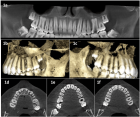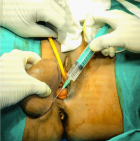Table of Contents
Maternal and fetal outcome of comparative study between old & adopted new value of screening of Gestational Diabetes Mellitus in tertiary centre in Saudi Arabia
Published on: 18th May, 2018
OCLC Number/Unique Identifier: 7671832754
Objectives: To check if there is any significant difference in the immediate outcome of pregnancy with diabetes using the new values of FBS & 2hrs post prandial with 75g OGTT for 1 year (from 1st June 2013-31st May 2014) in comparison to the previous data done in the same institute with other values and with international figures.
The data in our study included fetal, maternal morbidities, intra partum and postnatal outcomes, in order to help, if possible, on deciding the best values to use for screening for gestational diabetes mellitus. Furthermore, to know the new percentages of gestational diabetes mellitus in SFH by utilizing the new values of Blood Sugar readings.
Design: Retrospective cohort study
Setting: Security Forces Hospital-Riyadh-Saudi Arabia
Patients: Done (from 1st June 2013 – 31st May 2014), on patients who had attended Security Forces Hospital, Riyadh, Saudi Arabia. This chosen year’s data was compared with data collected in the three previous years using different figures.
Main Outcome measured: Average age of mother, maternal aspects of parity, history of GDM, number of abortions``````````````````````````````, estimated blood loss in labor, associated medical disorder, complications of previous pregnancies, methods of control of GDM, gestational age for IOL and associated intrapartum complications. Immediate neonatal outcome in cases of GDM, comparison of birth weights of babies & any specific congenital abnormalities and delayed causes of admission to NICU in the 4 years studied were also reviewed.
Results: The percentage of diagnosed cases of gestational diabetes mellitus (GDM) after screening was 24 % as compared with 14.5% in previous study of 2003-2004 & with the number of screened patients amounting to 93% out of the total number of deliveries between 2013-2014 (in both years universal method of screening was used). The multidisciplinary set up of our GDM specialized clinic which was composed of dieticians, diabetic educators, endocrinologists and obstetric physicians operating together, helped to reduced the use of insulin in combination with diet to only 24% in comparison to 76% of patient using diet and exercise alone. The study showed a mean age of 33years and weight of 77kg. It was also noted that 16% of the patients diagnosed with GDM were multiparous averaging 1-5 deliveries. Almost 62% of patient didn’t give any history of GDM and no history of previous medical diseases. The majority of the patient with GDM delivered without complications during labor, with 30% having vaginal lacerations & 73% of patient had an estimated blood loss of less than 500cc. NICU admissions secondary to hyperbilirubinaemia averaged almost 17% in comparison to previous studies and only one baby expired in a GDM patient. Our study revealed a good fetal and maternal out come with less delivery complications and less incidence of postpartum hemorrhage (5.7%).
Conclusion: It is concluded that Universal Screening of Pregnant women whether with previously used glucose value or new ones for gestational diabetes mellitus is a better option, which has proven to improve both maternal and fetal outcomes. The 75 OGTT test is a cost effective test and with both easy accessibility and good screening pick up number (92.5%) of the patients in Security Forces Hospital, Riyadh.
Recommendation: We recommend annual follow up for patients, both the mother and the baby after postpartum, to prevent the development of type 2 diabetes.
The Case of the Phantom Trophoblastic Tumor
Published on: 19th April, 2018
OCLC Number/Unique Identifier: 7586693742
This report provides an insight into a very unusual problem in the first trimester of pregnancy, and describes the unfolding of a series of potential blunders.
We all know that most problems in gynecologic oncology become terribly magnified when the patient is pregnant. HB had a routine ultrasound in the first trimester of pregnancy, and a large, extremely vascular mass occupying most of the lower anterior abdominal wall, was found (Figure 1). Because she had received methotrexate two years earlier for a persistent elevation of the hCG titer following surgery for an ectopic pregnancy, she was referred to the gynecologic-oncology service with the working diagnosis of metastatic gestational trophoblastic disease (GTD). An MRI showed a vascular mass in the subcutaneous tissue invading the rectus sheath and muscle, but not attached to the uterus (Figure 2). The report stated, in no uncertain terms, that the mass was strongly indicative of a metastasis from GTD. However, the hCG level was consistent with the estimated gestational age, and a mass such as this would represent an extremely unusual way for this disease to present. She had been told that she would need the have the pregnancy terminated, followed by chemotherapy to reduce the size of the mass prior to its removal.
Screening of Gestational diabetes mellitus
Published on: 4th April, 2018
OCLC Number/Unique Identifier: 7586666202
Gestational diabetes mellitus is becoming a very common medical disorder associated with pregnancy especially so in the Middle East and more so in Saudi Arabia, thus putting the women and fetuses at an increased risk of maternal and neonatal morbidity and mortality.
Screening for Gestational diabetes mellitus was recommended because of its asymptomatic nature and good proportion of patients with no classic risk factors. We recommended universal screening because of the beneficial effect of screening, diagnosis and subsequent treatment.
The most recent study done in Security Forces Hospital showed a significant decrease in morbidity and mortality with application of the new values of screening, in spite of the increase of incidence of Gestational diabetes mellitus from 14.5 % in 2005 study, to 23.9 % in the recent study in 2015.
Objectives: To highlight and determine the best screening method values of FBS and 2hrspp used to diagnose gestational diabetes mellitus.
Maternal & neonatal out come and associated risks for patients who had Gestational diabetes mellitus, where scrutinized.
The study was done in the period from June 1st 2013-31 of May 2014.
Design: Retrospective cohort study.
Setting: Tertiary centre (Security Forces hospital _Riyadh_Saudi Arabia).
Patients: Out of 6849 patients who had their delivery in Security Forces Hospital between June 2013 and May 2014 (one year), 6340 patients (92.5 %) were screened for gestational diabetes mellitus, and out of these 1516 patients (23.9 %) were labeled as Gestational diabetes mellitus after exclusion of cases of IDDM and NIDDM.
Main outcome measured: The purpose of this study is to advise on using new values for diagnosis of gestational diabetes and to assess the outcome of pregnancy after new values are implemented in security forces hospital for diagnosis. The outcome included ages of mothers, parities, number of abortions, associated medical disorders, and estimated blood loss. Control methods were also reviewed, gestational age of induction of labor. Associated intrapartum complications as well as fetal outcome were also reviewed. The weight of babies, congenital abnormalities, admission to neonatal intensive care unit were also studied. The different values used , and percentages of diagnosed values of last 3 studies done in Security Forces Hospital in comparison to the most recent study with new values(2014-2015) as shown in table 11.
Results: The incidence of gestational diabetes mellitus increased from 14.5 % in the year 2003 - 2004 to reach 23.9 % in 2014, in the same institute (Security Forces Hospital), where the study was done using different values. In our study in Security Forces Hospital we recorded a significant decrease in morbidity and mortality on applying the new values.
A significant reduction in the number of expired babies of mothers who were diagnosed as gestational diabetes with new values with a decrease from 5.6 % in previous years studied to reach 1.5 % in 2014, reflecting the effective control and the good catch for the new values.
Conclusion: Universal screening, with whatever values to blood sugar used, is a better method screening than the selective one: Using 75 gram of Oral Glucose Tolerance Test proved to be cost effective, easily accessible, and with good pickup rate of up to 93 % of patients in Security Forces Hospital.
Recommendations: To continue using the new values that will be universally implemented, with long term follow-up of mothers and newborn.
Is It Possible to End Female Circumcision in Africa?
Published on: 22nd March, 2018
OCLC Number/Unique Identifier: 7877963713
Female genital mutilation / cutting remains a widespread practice throughout Africa. There has been a worldwide effort to do away with FMG/C, but tensions exist between those who aim to abolish FGM/C and those who desire to perpetuate the tradition. While many Western and African experts and organizations agree on the health risks and human rights concerns with FGM/C, others fear that Westerners are imposing their ideas and lack of cultural understanding, trying to eliminate a practice central to the identity of many Africans. The issue must be approached respectfully and collaboratively, with great effort on the part of Westerners to understand the cultural context and rationale of this tradition. Ultimately, if FGM/C is to be eradicated in the foreseeable future, whole African communities and international support agencies must be engaged and empowered to collectively evaluate the implications of the practice and accelerate its demise.
TMD and pregnancy?
Published on: 14th March, 2018
OCLC Number/Unique Identifier: 7877876040
Pregnancy is a happy stage in life of every woman, but at the same time it is a rather difficult period, since pregnancy represents a serious strain on the body. In the body of a woman during this period there are significant physiological changes that ensure the correct development of the fetus, prepare the body for the upcoming delivery. In this difficult period, the burden on all organs and systems of the woman’s body is significantly increased. Especially often suffer joints; there is a risk of permanent pain, the development of diseases or exacerbation of existing diseases. One of the most common problems is Temporomandibular Dysfunction or Disorder (TMD) which many women face, but still hasn’t been explained.

If you are already a member of our network and need to keep track of any developments regarding a question you have already submitted, click "take me to my Query."

















































































































































